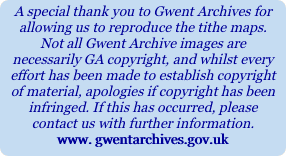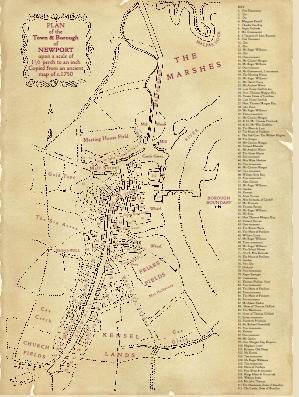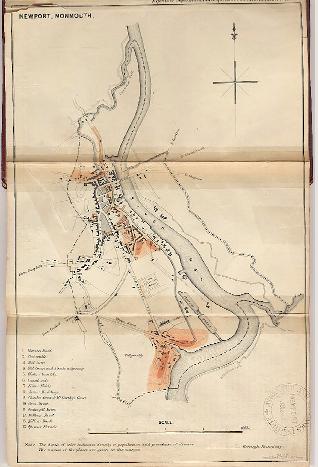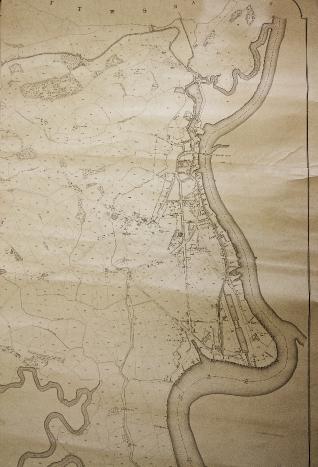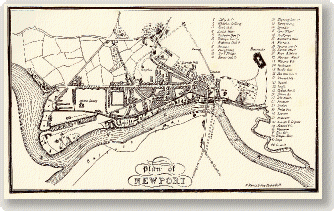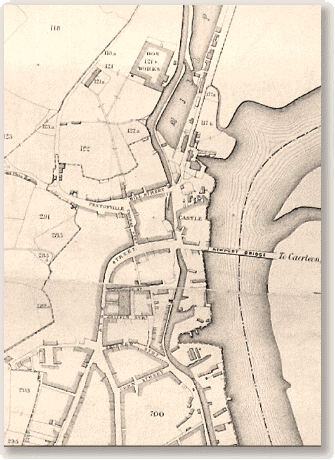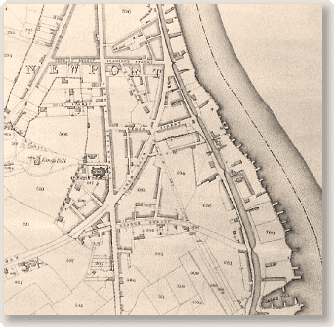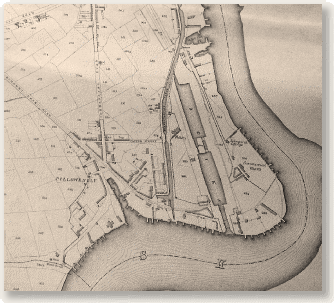

Newport during the 19th Century
An insight into the dreadful living conditions suffered by Newport's lower classes from the 1850 Report into the Sanitation of the Town
Newport was still a small town in the late 18th Century, with a population of just 1,087 in 1801. But rapid growth took place once a network of tram-roads had been established, bringing coal and iron ore from the industrial north of the county to the growing number of wharfs being built along the western side of the river Usk.
In 1807 The Tredegar Wharf Company was established and, as well as buying several areas of land for wharfs, obtained a 99 year lease on 200 acres of land in Pillgwenlly, on which the Company laid out a road one mile long and fifty feet wide (Commercial Street and Commercial Road) extending from The Westgate to their wharfs at Pillgwenlly .The Monmouthshire and Brecon Canal was constructed and opened in 1812. A new floating dock was planned in 1832, construction of which began in 1835 and, after a series of financial problems which halted the work on the dock several times, was finally opened in 1842.
Newport was soon becoming the fastest expanding town in the Country and, because of the huge influx of navvies and dock workers, housing was in very short supply. As early as 1821 the population had increased by two and half thousand to 3,496. In 1831 it had doubled to 7,000 and by 1841 was 13,700.
On the western bank of the river Usk, the ill drained, marshy ground at Pillgwenlly was being rapidly developed for housing, with no regard to first establishing a good network of drainage sewers and decent roads, so that by the 1840s a large slum had developed and disease was rife because of the squalid conditions.
………
If you had ancestors living in the borough of Newport during the first half of the 19th Century you will be shocked by the following descriptions of the dreadful living conditions endured by the poorer inhabitants of Newport.
………
The 1849 CHOLERA EPIDEMIC
It was during May 1849 that Cholera first appeared in Newport, leading to a total of 246 deaths in the borough.
………
THE CLARK INQUIRY OF 1850
(Transcribed extracts and website pages by Jo & Tony Doe)
The following Inquiry was commissioned the year following the Cholera Epidemic of the previous year:
PUBLIC HEALTH ACT 1850.
A Report to the General Board of Health on a Preliminary Inquiry into the Sewerage, Drainage, and Supply of Water, and the Sanitary Condition of the Inhabitants of the Borough of NEWPORT.
by GEORGE THOMAS CLARK, Esq, Superintending Inspector
" …….. The inquiry took place upon a petition from the Municipal Borough of Newport. The signatures attached are very numbers and include those of a county member, the present and late mayor, the vicar, several borough magistrates and members of the Corporation, 11 medical men, and a large body of rate-payers.
I found in all quarters great readiness to afford the requisite assistance, and there was placed at my disposal a mass of information relating to the sanitary condition of the borough, collected by the Health Committee, under the Board of Guardians, whose exertions have been carried out for several months past, and have been attended with much success. I received from various other quarters maps and plans of the town, and much verbal and documentary evidence concerning the sewerage and water supply. …..
GENERAL DESCRIPTION OF THE TOWN.
Newport is one of the largest and most important of those numerous towns upon the northern shore of the Bristol Channel, which owe their prosperity to the mineral wealth of the country behind and around them, and of which they form the outlasts and ports…..
The old town lies chiefly between the bridge and the hill of St Woollos, which rises 196 feet above the river, and is crowned by the ancient church of the same name, the mother church of the parish. Of late years, very considerable extensions have taken place along the flat bank of the river, in the direction of the ancient marshy suburb of Pillgwenlly, now a part of the town, and containing the docks. The old town is, therefore, in a better position for drainage than its low and level suburb.
…. The passage of the river, once difficult and commanded by a castle, the shell of which still rises above the right bank, is now rendered easy by means of a stone bridge, erected in 1801, and a hundred yards above which the river is again crossed by the timber and iron bridge of the South Wales Railway. The [river] Usk is navigable for shipping up to the stone bridge. The Monmouthshire Canal, from Brecon and Pontypool, with a branch from the [river] Ebbw, traverse the town, keeping near and parallel to the right bank of the Usk, and communications with the dock basin. Between the basin and the old town are numerous tramroads used in the conveyance of iron and coal. Both canal and tramroads, however important they may be to the commercial interests of the town, are not favourable to its sanitary condition. The canal checks the drainage of the town towards the river, and the tramroads, in their present condition, favour the accumulation of filth.
…. St Woollos Hill is composed of old red sandstone; a part of the tract which extends hither from Cardiff, and sweeps round to Abergavenny and Brecon, forming the eastern and northern margins of the mineral basin. Pillgwenlly is built upon an alluvial deposit of fine mud; and through this bed, here of great thickness, the channel of the [river] Usk passes below the town.
The Docks, which were opened in 1842, include a water area of 4.1/2 acres, with gates having a clear opening of 62 feet. The rise of spring tide is about 36 feet. Barracks have recently been erected on the north-west of the town……
The main street of Newport extends from the bridge along the Cardiff road. All the grounds upon the north side of this road is high; nearly all to the south of it is low. Much of the old and part of the new town is built upon the estate of Mr. Herbert, of Llanarth, which extends along the river to the docks. The greater part of the new town is the property of Sir C Morgan, of Tredegar. The owners of both estates let the land on building leases; the latter has let a large portion to the Tredegar Wharf Company, who are, therefore, largely interested in the prosperity of the town.
The natural level of the new town is from one to four feet below high-water mark spring tides, and is intersected by certain "reins" or ditches, under the control of the Commissioners of the Gwent-loog Level, who levy rates for the maintenance of these ditches and of the sea-bank. As the town has extended these ditches have become obstructed by house filth and street refuse, and in various places they are converted into lines of stagnant, semi-fluid offensive matter, into which, recently, it has been necessary to throw quick-lime to destroy the stench.
Originally, as the tram-roads were extended across this flat land, they were formed on embankments. Advantage has been taken of these to bring ballast, by degrees, from the shipping, and thus to raise the whole surface six to eight feet. A few houses were built before this was done. and these are particularly low and damp, and are seats of fever. Latterly every new house near the river has been built upon this layer of ballast, which, being usually shingle, is naturally dry, and affords great facilities for a good drainage.
Great credit is due to the Tredegar Company for their persistence in this arrangement. They also, as the reins become filled up with ballast, lay down culverts of large diameter to take their place …….
…. The petitioners state, with respect to the 1826 Municipal Act, - "That although for a portion of the borough there is a Local Act for paving, lighting, and for cleansing the town, its powers are very ineffective for all sanitary purposes. "That a large portion of the borough, chiefly consisting of the dwellings of the poor, is not included in the provisions of the said Act; and that in this portion the buildings have been rapidly erected, and many new street formed without regard to any system of drainage or surface cleansing." ……
…. There is, in fact, no public or general government in the lower town. Whatever has been effected there has been done under the Nuisances Removal Act, applied with a degree of energy, induced, no doubt, in great measure, by the dread and presence of the cholera.
Accounts of sums of money paid, laid out, and expended for the Improvement of the Town of Newport for the year ending 1st July, 1846:
Included were:
Lighting, Repairs of Roads and Footpaths, Scavenging and Cleansing, Repairs of Pavements, Watering the Streets, Construction and Repairs of Drains, Repairs of Pumps and Wells … Total £1,145. 0s. 9d
The Census Returns: 1831 Population - |
|
|
1841 Population - |
St Woollos Parish - |
2,951 |
The Borough, besides a part of Christchurch, with a very small population, includes the "town", with 8,225 inhabitants; and Pillgwenlly, with 2,590; total 10,815. The present [1850] population is, however, certainly very far above this, The area of the Borough is 3,120 acres.
………
MORTALITY
A Report submitted by Mr William Downing Evans, Clerk to the Newport Union Board of Guardians:
NUMBER and SANITARY CONDITION of the INHABITANTS of NEWPORT
August 22, 1849
"In 1841 the population was 13,244. The proportion of Births to Deaths throughout England (and nearly so in this country) is as three to two, so that communities are increased by the excess of births over deaths, supposing that individuals do not emigrate.
Immigration increases the population of towns, and it has been observed, that, where a considerable increase takes place from this cause the increase is small from the excess of births over deaths.
This is the case with Newport. From observations and calculations which I have made, I find that the births and deaths since 1841 have been nearly equal. The months of April, May, and June, 1846, included the healthiest period we have had here during the last eight years, in which quarter the births were 120, the deaths only 60; whereas in the three months ended June, 1847, the births were 150, and the deaths 245.
The following is the number of births and deaths registered since 1841:
Registration Quarters:
Sept 1841 - June 1842: Births 415; Deaths 439
Sept 1842 - June 1843: Births 418; Deaths 346
Sept 1843 - June 1844: Births 440; Deaths 365
Sept 1844 - June 1845: Births 485; Deaths 360
Sept 1845 - June 1846: Births 468; Deaths 325
Sept 1846 - June 1847: Births 545; Deaths 660
Sept 1847 - June 1848: Births 550; Deaths 685
Sept 1848 - June 1849: Births 565; Deaths 584
(Increase of Births over Deaths: 122)
The sub-district to which the foregoing numbers refer includes the greater part of the municipal borough of Newport, (that portion within the parish of Christchurch only excluded), and that part of the parish of St Woollos outside the parliamentary boundary …. It is nevertheless extremely difficult to ascertain the present number of inhabitants of Newport upon an estimate of numbers produced by this cause. One thing is certain, viz., that emigration cannot be mentioned here as a set off against immigration, because, assuming, as we fairly may, that the births registered in the last year bore a similar proportion to the inhabitants as the births registered in 1841 bore then to the population, we find that the number of the population is greater now than it was then by about 4,000. Without therefore going into more elaborate statement on this point, I assume that the present population of Newport is 19,000."
The Sanitary Condition of the Inhabitants of Newport
" … If a calculation be made upon the figures before given it will be found that the proportion of deaths to the population in 1 to 33, (30.3 per 1000). In 1841 the mortality in Pillgwenlly was exceedingly high, even above that of Liverpool. The mortality for the four years following was not so large, but since 1846 the deaths have very much increased, showing that an accumulating population without proper accommodation must necessarily subject itself to irretrievable loss.
In 1845 I delivered a lecture on The Economy of Public Health, and foretold the consequences of the state to which matters were then progressing. The localities which were then singled out as the nurseries of disease, have more than any others been the theatre of death.
From the 1st of June to the 30th November, 1848, out of 270 deaths registered there were 69 of disease of the bowels, chiefly dysentery and diarrhoea, 35 cases of scarlet fever, 1 of measles, and 3 of small pox. The town is scarcely ever free from fever of the low continuous form, but cases of primary typhus rarely occur, although the indigenous disease often terminates in a typhoid character ….. During the prevalence of the epidemic cholera here, the deaths have been, from the 31st of May to this date, (August 22nd), 112, all of which have occurred in the localities marked on the map as unhealthy.
The mortality from this fearful scourge would assuredly have been much greater had it not been for the effective manner in which the provisions of 'The Nuisances Removal and Diseases Prevention Act, 1848,' have been stringently and continuously applied. …. The Committee of Guardians and Associates have, during the last 10 months, issued 1,750 notices for the removal of nuisances, all of which referred to therein have been or are in the course of being removed. … On referring to the pauperism of Newport and St Woollos, I find that the proportion is as nearly as possible the same as the proportion of deaths to the population, viz., 1 in 33, excepting the casual and vagrant poor. The average number of fixed paupers the last half year was 500.
From these observations I infer, that the condition of Newport is capable of being highly improved. This situation of the town invites the adaptation of all that is essential to the security of health; its growing importance demands that public intrench essential to its permanent prosperity; and the voice of its inhabitants having claimed that protection which they not only deserve but must have or perish, I conclude by expressing a hope that the statistics here given will have some weight in securing the object now sought to be attained.
W Downing Evans
LOCALITIES of DISEASE
The map appended to Mr Evans's paper, illustrates also what follows upon this branch of the subject.
With reference to the seats of particular diseases, Mr Brewer, Medical Officer to the Eastern Division of the Newport Union, in a report for the year 1839, from which it appears that, out of 216 deaths, 116 were due to fever, observes:
"A great majority of these case of fever have occurred in the "Friar's Field,"which is situate in the lowest part of the town of Newport. It consists of two or three rows, and several courts of miserable dwellings, which are generally the resort of beggars, prostitutes, and Irish vagrants. The whole neighbourhood is in the most unhealthy state; the drains are stopped, and accumulations of filth present themselves on every hand. Many other cases of fever occur which do not appear in this return, as medical relief is in some instances afforded by a neighbouring dispensary."
It will be seen afterwards, that the interval of 10 years has produced no sensible improvement in the condition of Friar's Fields. Mr Woollett, Surgeon to the Dispensary, laid before me the following statement relating to the seats of a particular class of diseases:
"The evidence I have to offer upon the sanitary state of Newport is based upon the experience of ten years official connexion with the Dispensary of the town; during which period upwards of 10,000 persons have required medical aid.
It is proper here to observe, that none of these are recipients of parish relief, these forming a distinct class, and having medical officers of their own; nor do any of them belong to Benefit Societies, which are similarly provided with medical relief. They are a class of people removed from the former, and placed generally under the same circumstances as the latter; and it may be fairly assumed that amongst those classes of the community there is the same average amount of epidemic disease.
Almost the first matter for remark which presented itself to my notice was the continued prevalence of typhus fever, especially in the more crowded and dirty parts of the town, It was, and up to a late period it has continued to be, endemic in particular districts. In the unfinished and undrained streets; in Fothergill Street, Friar's Fields, Mellon's Bank, Club Row, Rees' Buildings, and other streets, with all courts in their various localities, and in Pillgwenlly generally, typhus fever as well as other epidemics rage with the greatest violence.
Scarlet fever, measles, and small pox, when occurring in these districts, are more malignant in their character, and meet with circumstances favourable to the prolongation of their stay."
………
INSPECTION OF THE TOWN
[listed street by street and not alphabetically]
…… The summit of the town, near the parish church, is very imperfectly drained, and very badly supplied with water. Here, upon the southern slope of the hill, one of the best situations in the town, is a group of cottages known as the "Rookery", composed of 16 houses, built back to back, with rising ground above them. The open drain from the Fever Hospital passes close to the front of one row, but does not receive the drainage of the houses. The want of back windows renders the rooms very close. There are two privies to the whole (16 houses), which discharge into an open ditch on the border of the Vicar's garden, as does the Fever Hospital drain, and together they produce a very serious nuisance ….
…. Stowe Hill, leading from the church to the bridge, is a broad steep road, along which there are 98 houses. Most of these are of the better sort; the road, however, is without any covered drain, the house drains discharging beneath the raised footway into open gutters by the wayside. As these gutters are formed in steps, the offensive fluids collect and form small pools, much complained of. The houses on the north side of this road have privies in the gardens, the contents of which ooze into Bain's-Well lane. The public pump here, at the time of my visit, was dry …..
Along the Cardiff Road are several ill-conditioned places. The road itself is very badly drained, the gutter-grates are large, and give off unpleasant smells. The side of the road is used as a receptacle for all kinds of refuse from the houses opposite. Most of the houses in the main street are well built, and all have back premises and privies.
Beynon's Court, opening from Queen Street. Here are nine houses, of which six are without back windows or efficient drains; the court is but partially paved; the floors are rendered damp by the hill above. There are two privies, but without drains. Want of water is severely felt; the Salutation Pump, besides being so far distant, is by no means sufficient to supply the surrounding population.
Rees' Buildings. Here 13 houses have been made to lodge 18 families; of these six are on one side under ground, having a narrow area in front, and no back window to premises. They are very close and damp, and quite unfit for human beings to live in. There are two privies to the whole, which are in a ruinous condition, and the pump is out of repair. Some of these houses are let as low lodging houses. Fever is constantly present. The Sanitary Committee have been very active, and have caused a stagnant ditch to be filled up, but it is quite obvious that such activity will not be always maintained, and then these places will revert to a condition even worse than that in which they at present are.
Near this is the spacious Cattle Market, and the sheds, &c., erected by the Tredegar Wharf Company, to whom they do credit. The market contains, however, only two pumps, and is only partially paved.
Commercial Street contains 176 houses, and forms part of the great street of Newport. On the west side most of the houses have proper drains, terminating in a sewer which falls into the Pill [at the end of Griffin Street]. On the east side the houses drain upon the low ground towards the canal, and the fall being deficient, a serious nuisance if produced. Much of the semi-fluid ordure which affects Friars' Fields comes from this source. The canal is at present the great obstacle to a perfect drainage
McCarthy's Court, in this street, contains, with some good houses, others in a very bad state as regards drainage and ventilation.
Gainey's Court has eight houses with one privy and a surface drain.
In Charles Street are 30 houses, most of them connected with the culvert in the street. Six are low lodging houses, sublet into different apartments, and very much overcrowded, as, for instance, the house in the occupation of the widow Bartlett, consisting of five rooms, is inhabited by 30 persons; each room used for all domestic purposes during the day, and as a sleeping room at night. Most of these lodgers are collectors of old rags and bones, which are heaped up in the rooms. In some of these lodging-houses large quantities of dried fish are kept until they are often in a putrified state. In others are vegetables, such as remain unsold during the day.
Hill Street contains 37 houses, and is without a sewer. The house-drains terminate in the open road, but it was stated that the Sanitary Committee compelled the owners of the houses at each side of the street to make a small drain into and adjacent culvert. On the south side of the street are privies without drains to them, and discharging into the fields, which are now becoming occupied as building ground, and quite within the town; these privies are very offensive. Several of the houses at the north side of the street have imperfect drains to the privies, but a number of the upper houses are without even these. The decomposing matter from the Hill Street churchyard finds its way into the wells in Commercial Street in its vicinity, and renders the water very offensive, and quite unfit for use.
Victoria Place is a row of well-built and neat houses, letting at from 35l. to 40l. each, per annum. Below The Rookery is King's Hill Well, a spring much in request in the neighbourhood. Mr Scott states that: "There were seven or eight small cottages on the right of Hill Street which, in addition to being badly ventilated, have most inefficient privy drainage at the rear, wanting fall, and better connexion of the privies therewith. there is also but a small supply of water on the premises; and sickness has been general there, throughout the prevalence of the cholera, of which one tenant died."
Commercial Road, the prolongation of Commercial Street, is one of the main thoroughfares of the town. It receives a culvert from Hill Street, which, however, is not intended to receive the house drainage. Close to the road are some open ditches, stated to receive house drainage, and rendered stagnant by the ballast heaps now being extended over the ground. I found the worst places saturated with quick lime. Like most of the principal streets, this is broad, and contains many excellent houses.
The Baptist Chapel Burial-ground is much complained of this quarter. It is placed in the town, on a very wet hill side, and it is very full, and renders the drains offensive. Near is the Tabernacale Chapel yard, behind the Bank, the water of which is affected by the exudation from the graves. All one side of Llanarth Street is more or less affected in the same way. This burial-ground is very full. [see also Tabernacle Chapel and also Llanarth Street]
Friars' Fields include a considerable tract of land between Commercial Street and the river, and, though low, quite capable of being drained. This ground has been built on may years. The Sanitary Board called on the proprietor, Mr Herbert, to make a drain; a difficulty presenting itself as to getting under the canal, a drain was made, which, at its lower end, is merely a little more than a surface-drain, the water from which empties into the canal. To drain the place effectually, an outlet must be made under the canal into the river. It is understood that Mr Herbert would be willing to take a share with the authorities in defraying the expense of this work, but at present it cannot be carried out.
Regarding these fields, Mr English states:"There are 96 houses in Friars' Fields; 55 are without privies, and 41 with privies, but without drains. There has been a culvert lately made by the orders of the Sanitary Board, through the fields extending from Irish Row to the canal, where there is a cesspool and a small drain to let off the surplus water into the canal, but under the existing law there is no power to compel the owners of the houses to communicate with the culvert." The culvert, in fact, was only made to drain this low and marshy tract, and to render it fit for building purposes. "These fields are neither paved nor macadamised; the rain water stands in pools on the surface. This place is always in a most filthy condition, and one of the chief evils existing there is the keeping of pigs in small confide yards with no drainage. There is an open ditch running all along Union Row, taking a course through the Friars' Fields Garden, about 200 yards long, and most of the inhabitants in the Fields empty the contents of the chamber utensils in it. Fevers, nervous pains, and sickness of stomach, frequently occur here, which they refer entirely to the bad smells from this ditch, but which are no doubt aggravated by the intemperate habits of the class of persons residing here." [Mr English]
This whole tract of ground is indeed at present in a very discreditable state. Here are courts within courts, close, damp, and very filthy, with typhus in an aggravated form continually breaking out. Davies' Court is a cluster of houses. Rees' Court is particularly close. The Barrack is very foul. The cholera began here.
Union Row with 29 houses, Nicholas Row with seven houses, are both without back yards or windows; many without privies. The house refuse is usually thrown into the street, which, in the case of the latter [Nicholas Row] is unpaved and very muddy.
There are 16 houses in the Old Barracks built back to back, very close, and surrounded by numerous open and very filthy drains, into which, and a large open pit, in the absence of a single privy, refuse of every description is cast. The people complained of the offensive smells, and of the utter neglect of scavenging.
Rees' Row - here are five houses built back to back against other houses. The privy belonging to the 'Boatman's Rest' beer shop is set up against the bakery next door, and the drain from the privy runs along the bakehouse, and is only loosely covered with flags [paving slabs] but is at the moment under alteration; a Mrs Burke lives over the bakehouse, and there being no sealing, the heat at times is suffocating; under this woman's bedroom window there is a privy without a roof, now disused, but full of filth, the heat of the bakehouse causes this privy to small dreadfully, and the woman is constantly ill, and receiving parochial relief. The other three houses have privies in a hole adding the kitchen. There is a drain to them, but it is now choked. The privies are all without ejects, and the smell, especially at night, is dreadful. The street in front is full of holes, and very dirty.
Near this is Irish Row. Here are 22 houses, three of them are built up against three others in front; six have back yards, but no drains to take off the surface water, which flows into the houses; these houses are each inhabited by several families; each family takes a room, and then sub-lets it. They are very much overcrowded. There is not a single privy to any of the houses. The street is at all times full of pools of water, and in the winter time is almost impassable. The remaining six houses opposite have very small back yards and privies, but the drains are so small that they are always stopped up. No communication has been made from these 22 houses in Irish Row to the culvert lately made in front of the doors; the Nuisances Removal Act not enabling the Sanitary Board to compel the owners of these houses to make drains to the culvert.
Cross Street Lower. Here are 25 houses, of which 12 have a back culvert, but choked up towards the canal. The other 13 houses have no drains to their privies. This is reported as "The dirtiest and filthiest street in the town, full of holes and hollows. All the domestic refuse thrown from the houses into the street, which is never properly cleansed; there is a tram-road running through it. The Sanitary Board were compelled last winter to employ men to scrape the street and carry off the filth in trams. A number of pigs are kept in this street to the annoyance of the neighbourhood." [Mr English]
This part of Cross Street is beyond the jurisdiction of the Town Commissioners. One side is built on the property of Mr Herbert, the other side on that of the Tredegar Wharf Company. The Monmouthshire Railway and Canal Company have three tram-roads in the centre; neither cleanse it.
Cross Street Upper contains 25 houses, with a small inefficient drain. Eleven houses are without privies, and several are in a filthy state, and let as low lodging-houses, chiefly for the Irish.
In Florida's Court are four Irish lodging houses with two to three families in each; they have no back windows or yards, and the rooms are seriously overcrowded and close: the privy is in a bad state.
Fothergill Street: "There are 21 houses in this street, several consisting of four or five rooms, occupied by separate families, and again sublet by them to eight or ten, or sometime twelve to fourteen persons, nearly all Irish, having but the limited accommodation of one room, in which they all sleep in beds made of shavings and rags, on the floor, with windows closed and the fire-places stopped up, breathing the same atmosphere over and over again; this very room having been used for all household purposes during the day, and in some instances having had wet clothes hung up to dry in it. Previous to the institution of the Sanitary Board, I seldom visited these houses unless in search of bad characters. Since then I have had recent experience of the misery, disease, and death generated by these ill-regulated and over-crowded dwellings. I have found five beds in one room, six men in each bed, three with with heads in one direction, and three with their heads in the other, one had fever; these are mostly Irish lodging-houses of the worst class. In one instance I found 42 human beings sleeping in a room of 12 feet by 14 feet. The atmosphere was insufferable. It is no uncommon occurrence to find old women or children sleeping in cupboards with the doors closed, and in one case the straw bed had not been changed for two years, and in another the mother of the tenant was found with three grandchildren sleeping in a small cupboard 20 inches wide, and 4.1/2 feet long.
The tenants are willing to pay 2d. or 3d. a week for water, but the landlord refuses to make the necessary outlay for fittings &s., although offered by the Water Company at a reduced rate. This street had no drains or surface gutters, and is always in a filthy state, as all the slops and refuse are thrown into the highway. One side of the street is in the new, and the other side in the old Borough, and this may account for the neglected state of the place. There is a slaughterhouse here, lately erected, adding to the impurities of the place. These cottages are let by the week, and pay no rates, although a valuable property to the landlord. For example, Margaret Holland's house is divided into four compartments, each of which lets at 2s.6d, a week, being 26l. per annum to the landlord, and no poor rates to be deducted." [Mr English]
Such is Mr English's account., When I visited the place I saw quite enough to bear out its leading features, although something had been done temporarily to promote cleanliness.
Jones' Court, in Fothergill Street, contains 11 houses of a bad description, very dirty and overcrowded, without back windows, and with but one privy, quite insufficient for the numbers resorting to it. The tenants said they would willingly pay 1.1/2d. to 2d. a week for water, but the landlord refuses to lay the service pipes. The state of the lodging-houses here is described by the Superintendent as at times very bad indeed.
Kear Street also contains lodging-houses. To describe this, would be merely to repeat the above account.
Canal Side. Between Cross and Llanarth Streets are 17 houses with a choked up drain, the cellars described as liable to be flood. Highley's Court is without back yards or windows; the houses are of a good description, and tolerably clean, but without water. Toombs Court is of the same character. Reform Buildings contains nine houses, sublet and much crowded. the place is rendered close by the tram-road wall in front.
"In Club Row are 33 houses with privies to each house, but no drains to the majority of them; there is a high wall behind these houses about 10 or 12 feet high, and a wall in front dividing the tram-road from houses, which make the place close and ill-ventilated. There are several families in each house, and pigs are kept in almost every yard, vitiating the surrounding atmosphere. A few houses have the water supplied to them by the Water Works Company." [Mr English]
In Jones' Court and Perkin's Buildings the houses are very much crowded together without either back yards, back windows, water, or proper privies. The refuse is thrown into an adjacent open pit.
Mellon's Bank contains 23 houses without a sewer, and some without even a surface gutter. One of the privies oozes into the open road. Here are several Irish lodging-houses sublet, and much overcrowded. It is the custom in these places when a lodger is taken ill to place him near the door of the relieving officer. The Sanitary Committee have attacked the pigsties here with good effect.
George's Buildings also swarm with low Irish. The houses are dirty, without drains, and damp, from elevated back premises, and a high wall in front. The street is unpaved, cows are kept in one of the yards, and the privies throughout are in a disgusting state.
Mellon's Square is the seat of epidemic disease, and as such was brought under the notice of the Sanitary Committee by Mr Buchanan, surgeon. The history of this place is instructive: "The Sanitary Officer, their agent, found it unfit for human habitation; the owner was summoned before the magistrates, when he stated 'it was as sweet as a nut;' the magistrates visited the spot, and ordered the numerous nuisances, such as piggeries, heaps of dung, green stagnant water 2 or 3 feet deep, and large heaps of ashes with the usual accumulations of decomposing excrementitious and other matters, to be immediately removed. The landlord was afterwards compelled, at a considerable outlay, to make a culvert into George's Street, and since then the aspect of the whole place is altered. Fever has disappeared, and the comfort of the inhabitants very much improved. Some of the houses now are badly ventilated, being built back to back. It is due to the landlord to state that he has latterly made some improvement in the property." [Mr Buchanan]
Caroline Street has neither sewers nor surface-drains, except at the back of some "club-houses," where there is a good culvert extending as far as the end of Dock Road, but it has no outlet, and its contents ooze through into Dock Road, and contribute to the unwholesome charters of the stagnant accumulations there.
Mellon's Street: "Has a culvert, and the owners of 13 houses have availed themselves of it, but it is bad order. Its course is long the Dock Road to the 'Hope and Anchor,' near which it frequently burst out into the road, five of these houses are low Irish lodging-houses overcrowded, and the infant mortality here is greater than any other part of the town. At the back of these houses a piggery was recently kept for the use of the Irish cattle dealers, and had been let for as much as 16s.8d. a night."
Ruperra Street is unfinished and without drainage, with the exception of a culvert at the back lately made, but which does not appear to have sufficient fall to be efficient.
New Market Street. Here are 37 houses without a culvert or public covered drain. The New Market culvert crosses the end of this street. The roadway has recently, on the representation of the Sanitary Board, been coated with stones.
George Street is also in an unfinished state, and the road-way in wet weather is very filthy. A few yards of culvert have ben made by private persons in front of their own houses, but it has no outlet, and it is stated that its contents ooze into the cellars.
Potter Street. There are 18 houses in this street, of which 15, known as Pyne's Row, are built on the low original level of the land, and are also blocked up by the embankment of a tram-road in front. The back drain has not sufficient fall, and the houses are rendered damp by the water from the front street, which has no drainage. The houses are not supplied with water, and the privies are undrained. A culvert runs from the back of Pyne's Row to the Pill
Pottery Lock Terrace. Of the 12 houses in this road 4 are undrained, and the drains of 4 discharge into the canal. The road is dirty, unfinished, and undrained.
Church Street. The houses here each occupy the usual allotted to a "taking" that is to say, 16 feet frontage, and 60 feet in depth. Frequently, in other parts of the town, the space thus allotted originally for one house has been sub-let, and a second built upon it; an abuse which is one cause of the dreadful state of some of the South Wales towns.
Jones' Court, Pillgwenlly, is one of a series of courts along the course of the Monmouthshire Canal Railway, in which cholera prevailed. They stand on the original very low level of the ground; the fronts are entered from the first floor, and behind is an entry on the ground floor, both being tenanted; these lower rooms are low, damp, filthy, and unhealthy. The rent is 2s.4d. a-week for one room, and two cupboards used as bedrooms. There is a public refuse pit in front. The public privy here is in a dangerous condition and very filthy. Fever and diarrhoea continually prevail among these people, many of whom are Irish.
Commercial Wharf contains 18 houses, 5 without privies or backyards, the refuse being thrown into the street. Here are nuisances created by stables and pigsties in a dirty state. A main sewer has been made, but the people are only allowed to join it on paying their share of the cost.
Behind the Commercial Inn are a number of cottage tenements, built on ballast, but without efficient drainage or privies, and very filthy, and the road is unformed.
Clarence Street contains 31 houses and is without a drain. Some of the tenants have sunk barrels into the ground to collect the surface water. The road is unformed.
New Street. Here are 25 houses without a sewer; a tram-road passes through the street, which is imperfectly formed and in a dirty and damp state; the back premises are very close and confined; the house owners cannot put in drains for want of a main sewer; at present holes are bored in the back premises to aid the water in soaking away.
Court-y-bella Terrace. Here, where there is a main sewer, the house owners have neglected to make drains into it. There are several low lodging-houses in this street, usually much over crowded and always in a filthy state; the cellars, which are in several places occupied, are quite unfit for human habitation.
David Morgan's Court. This is a low ill-ventilated place, suffering from the effluvium from dung-heaps connected with the adjacent stabling. There is no efficient drainage.
In Tapson's Court are five houses with one privy; the houses have no back windows or premises, and their refuse is thrown into the road, the surface of which is very imperfectly formed.
Company's Row. Here, as in many other places, the front door is on the first floe, and the ground floor partially a cellar habitation. Six houses here have no back yards, and are liable to be flooded owing to a defective state of the culvert. The lower rooms are damp, of small dimensions, and without ventilation or direct light; these are among the worst premises in the town.
Baldwin Street contains 38 houses, without any drainage to one side, and there is a close place behind into which the house refuse is thrown out of the reach of the [refuse] cart. The Tredegar Wharf Company have recently drained the other side, but the privies do not communicate with the drain. An open ditch behind Mr Cavin's store is much complained of.
Protheroe's Row. Here a blocked up drain, designed to discharge into the canal, receives the contents of the privies of eight houses.
Dock Parade contains 14 houses without a culvert, excepting a very partial one crossing the street under Devonshire House. The road is incomplete and a nuisance. Here are seven houses back to back, close, without back openings of any kind. The house refuse is cast into the street, which is unprovided with drains. The inhabitants are forced to use canal water, which is often in a filthy condition [see Protheroe's Row above]
Quiet Woman's Row. These houses are without back premises. Their position is low as regards the dock, and they are damp. In front of them is a tramway in a filthy state, and they are badly off for water. There is a public open pit for house refuse. "There is one privy to 14 houses, open to the road, without a drain, always full, and built against the side of the ashpit, the smell is very bad. The owner of these houses took no notice of the order of the Sanitary Board, and was obliged to be summoned before he would empty the privy and ashpit."
Dock Road is described as possessing the best culvert in Newport. At the time of my visit it was in progress at a very considerable expense.
Granville Street. These houses have been lately built. Those on the left-hand side of the street have drains from each into Mr Hunt's culvert in his yard. The yards are too small, close, and confined. Privies but no dust-bins or other convenience for domestic refuse, and situated where there is no system of scavenging, the people are consequently compelled to throw their ashes out into the street. The houses on the other side are better situated, but have no culverts or drains; there is a small surface drain now in progress.
KIng's Parade contains 53 houses, with only two short surface-drains running into the Canal. The privies also are without drains; they join those of the houses in Castle Street. Fifteen of these houses have only one privy to the whole. The street has never been finished, and is in a filthy state. All the house refuse is thrown into it.
Wedlake's Court. Here, also, the lower floor is constructed as a cellar, with an entrance at the back. The floor stands on the original level of the soil. Fever has prevailed here. With reference to this court the Superintendent states: "Here are 14 houses, 11 of them have no ventilation; are inhabited by low Irish, low in position, filthy, and unhealthy. The drain is covered with loose flags [paving slabs] and a board, and has not sufficient fall. The privies also are filthy. The lower part of these houses are not fit for people to live in. Before the Sanitary Board came into operation this was one of the worst courts. In the middle of the court there was a large ashpit into which all the house refuse was thrown, and this was built up against two privies, the contents of which flowed into the ashpit, and so impregnated the atmosphere, that it was most unpleasant for a person not accustomed to the court to enter it. The Medical Officer of the Union, when visiting a patient, could not remain in the court, the stench was so intolerable. Summonses were obtained against the landlord to remove these nuisances; he employed a solicitor, and, upon a clerical error in the summons, defeated the Sanitary Committee. Another summons was obtained, and the magistrate's order was at last complied with. There is no water in this court. The tenants are willing to pay 2d. or 3d. a-week for it, but the landlord will not make the necessary outlay for the fittings."
Watchhouse Parade is built upon the ballast-bank from the shipping, here from 6 to 10 feet high. The road is at present unformed, and without a sewer. The state of this street has been frequently complained of by the surgeon to the dispensary.
The Barrack Cottages, five in number, are built close to an unhealthy stagnant pool, connected with the Old Mill.
Canal Parade. Here the sewer is out of order, and the cellars occasionally flooded. The privies are without drains.
Llanarth Street contains 44 houses. The street has a properly built culvert, but part of it is laid at a dead level, and will not discharge its contents. It is now blocked up, where it passes under the canal. The Tabernacle graveyard seriously affects the wells in this street.
Union Street, with 16 houses, has privies with drains. Water is scarce, and the condition of the highway is very bad. In Jaynes Buildings are eight houses, all with privies, though placed rather too close to the houses. The landlord has made a street culvert, but for want of a proper main sewer it is not of much use. The houses are clean, and have a water supply. "In Union Court there are 12 houses without back yards or windows; four once had back yards to each, and pieces of garden attached, but the landlord lately converted them into houses (now called John's Court), and stopped up the doors leading into the gardens. All refuse is thrown into the street. These tenants use the privies in the courts adjoining. Several cases of cholera have occurred here."
John's Court contains five houses without back yards or windows, the single privy is without a drain, and very filthy. No water. The entry is by a close-covered passage.
Taylor's Court. "Here are five houses. They have no back windows or rears; the court is close and confined, and the inhabitants are obliged to open their bedroom windows at night, in consequence of the closeness of the atmosphere. The houses are built back to back. All clothes are dried in this narrow passage. No water here. Size of court, 5.1/2 feet wide, 28 yards long."
Thomas' Court, with five houses, is much in the same condition and suffers besides from oozings from a most offensive privy. No. 5 Court is close to a slaughter-house; much complained of. Several fatal cases of cholera occurred in these close, damp courts.
In Dock Street are 19 houses of a superior class, but the street is unfinished and a pool of water is usually to be found in it. The owners of this street have not conformed to the local Act as regards its width, on which account the town authorities have refused to adopt it.
Llanarth Cottages; near these the magistrates have lately directed a culvert to be made in place of the open ditch, which is stated to have been very offensive before the order was given.
Dolphin Street is a new street of 60 houses, but in a filthy condition. "… having a tram-road running through it. A magistrate's order was obliged to be obtains by the Sanitary Board before the owners would fill up the pools of stagnant water which the medical men reported as engendering disease in the neighbourhood."
Griffin Street contains 11 houses, of which three are employed as public, and one as a private slaughter-house. It is difficult to describe the nuisance thus created in the midst of a crowded population, with bad drainage, and no sanitary regulations in force, and a very imperfect supply of water.
High Street, Pillgwenlly, contains 46 houses without culvert or efficient covered drain. It has a tram-road through it, which is a source of much dirt. One side of the street is sub-let to low Irish, and is particularly crowded and dirty. Two of the public-houses in this street are drained directly into the Pill.
Castle Street, Pillgwenlly, consisting of 45 houses, is chiefly the residence of the lowest class of Irish. It is unpaved, undrained, and very filthy, the house refuse being thrown into the gutter. The owners have been summoned, but they plead, and with great justice, the want of a main sewer laid by the town.
There are 17 houses in Castle Precincts, four of which have a public privy but no drains, and the other 13 have no privy at all; the refuse is thrown into the street. These houses are built against the Castle Brewery, very closely packed, and are without back windows. The railway wall in front has rendered them even more close and damp than formerly, and in nearly every house cases of cholera occurred. Four of these houses are below high-water mark. The whole ought to be swept away as unfit for the abodes of human beings, and as involving, by the production of sickness and pauperism, a heavy addition to the local taxes.
Pentonville is a very damp street, the condition of which is very bad indeed. It is noticed here on account of the large number of cases of cholera which occurred in it, and which were attributed to the contiguity of the Mill Street Chapel yard.
The Marshes Road contains 78 houses, of which 63 are built 5 or 6 feet below the level of a large pond: the privies of all of these house, placed above them, discharge into this pond at its margin. Three or four of the house-drains discharge into an open nearly stagnant ditch in front of the road, and into which domestic refuse of every description is thrown. At the time of my visit it had been partially covered with quick lime by direction of the Sanitary Committee. The situation of these houses, between the pool and the ditch, is very unhealthy.
With reference to Mill Street the Superintendent observes: "Here are 22 houses; 9 of them, adjoining the railway, have no privies, and there is a wall about 8 feet high at the back, leaving only a space of 4 feet for a back yard. The 13 houses opposite have privies, with a culvert running into the canal, made under the direction of the Sanitary Board, with the exception of five of them, which have no drains. There is a surface-culvert in this street, running into the canal. Before the operation of the Sanitary Board it was an open drain. Its contents, including the refuse of slaughter-houses and privies, now empty into the canal. Several of the houses are low lodging-houses for tramps, such as "girdlers" [world-wide travellers], "shallow-coves" [half-naked beggars], and "high-flyers" [genteel beggars or swindlers], and others who make a regular system of travelling all over the country. These lodging-houses are very frequently dangerously overcrowded, the rooms being close, confined, and ill-ventilated, and the males and females' indiscriminately huddled together."
Mill Street Welsh Independent Chapel yard (elsewhere noted), is upon the wet hill side, and very full. The ground is higher than several of the houses, and the exudation is said to drain upon them.
………….
SEWERS and DRAINS
Newport is very insufficiently sewered. Parts of the town are without any sewers at all, and in others the sewers are intended solely for the removal of surface-water, the householders being strictly forbidden to drain into them. It is of course impractical to enforce, in all cases, such a prohibition, and in consequence, the large, untapped grates of such sewers give out most offensive stench in the streets, and their contents render the waters of the canal, into which many of them discharge, very impure ….
WATER SUPPLY
Newport derives its water from rain, from wells and pumps, and from the water-works. Rain-water butts are expensive and cumbrous, and the lower class of cottages have neither expanse of roof to collect, nor can they afford the expense of storage arrangements.
There is a public spring or conduit at Pillgwenlly, fed from a source near St Paul's Church. The public pumps are Baneswell, and the pumps in Mill Street, Corn Street, Stowe Hill, and Salutation. The supply is very insufficient, for the wants of the town and the cottagers suffer materially from scarcity. For ordinary purposes they have recourse to the canal, the water of which is very dirty, many of the houses draining into it. Near some of the burial yards the springs are tainted, and many of the ordinary springs fail in dry seasons.
The Newport and Pillgwenlly Water Works were established by Act of Parliament, 1846, and completed 1848, at a cost of about 27,000l. They are in the hands of a Joint Stock Company; to the chairman of which, Mr Cordes, as well as to Mr Morris, their surveyor, I am indebted for most of the following particulars:
The main reservoir is 1.3/4 distant from the town. It covers 14 acres, contains 146,000,000 gallons and its top level is about 80 feet above the Newport Dock coping, which may be taken as high-water mark spring tides. The reservoir is fed chiefly by springs; it also receives drainage of about 500 acres of gathering ground ….. From the storage reservoir the water is led by an iron conduit pipe of 12 inches in diameter, to the lower service reservoir upon Stowe Hill. This is lined with masonry, and contains 158,000 gallons. Its top-water level is 66 feet above high water-mark.
By the side of this tank is placed a condensing steam-engine of 5 horsepower, by which the water is forced up by a 6 inch pipe into a second service reservoir, on the top of Stowe Hill, also lined with masonry, and containing about 50,000 gallons. The top-level of this reservoir is 196 feet above high water-mark. Besides this, is a small stand-pipe, not at present used, 20 feet higher, by means of which the highest service is laid on. The engine will lift 170 gallons a minute, an ample supply for the limited number of houses, about 200, which, from their elevation, might require to be supplied from the upper reservoir …… There are in the borough of Newport 330, and in the parish of St Woollos 500, houses rated under the poor's-rate at less than 10l. per annum; of which class, only 25 gooses are supplied with water by the Water-Works Company; thus showing that the lower classes of the community are very scantily supplied, a circumstance arising from the indisposition of the landlord to lay out a few shillings for the comfort and convenience of the tenants - e,g, a landlord who owns 20 small tenements in a court, sheltering, on an average, 400 persons, objects to pay 1l.16s. per quarter, for a constant supply to these tenements, and a charge of 35s. for the necessary fittings.
This indisposition or positive refusal on the part of landlords of cottage tenements to lay on water is manifested in every town which I have inspected, in which there are Water-Works, and although this disposition to stand in the way of improvement in the the comforts of the lower classes is most commonly exhibited in the refusal of water, it will be found to exist as strongly against improvements in house drainage and similar matter.
STREETS and ROADS
The highways in the Old Borough are under control of the Improvement Commissioners, who provide for their repairs and scavenging out of the general rate. The roads, excepting the main street, are not in very good order. The Commissioners' control does not extend to private streets, or courts, and in consequence these in most cases have not metalled surface, and are in a damp and dirty condition.
The footways are very irregular. The Commissioners have only the power of repairing the footways, but they can neither make them nor call upon the inhabitants to do so, and as a necessary consequence the tone is very badly provided in this respect.
The highways in the lower town are under the control of the Tredegar Wharf Company, who have not delivered them over to the parish. Most of these roads are badly formed, and in a dirty state. The houses have been built along the lines of the tramways, which collect dirt and damp. The footways are much broken and interrupted, and the courts and alleys are either unpaved or very badly paved.
SCAVENGING
There are no provisions for public scavenging in the New Borough. Most of the streets are incomplete, and are in a filthy state from muss, house-refuse, and ordure. Very recently the Sanitary Committee effected the removal of a part of the accumulated filth of 9,000 persons, their measures however are but of a temporary character.
LIGHTING
The Old Borough is lighted by 96 public gas-lamps, which are provided by the Town Commissioners. There are besides seven private street lamps. This number of lamps is obviously very insufficient for the 1,295 houses contained in this division. Even in the main streets the lamps are but few, and many of the bye streets and alleys are not lighted at all. The New Borough, containing 1,237 houses, is not lighted by an public lights. There are 20 street lights belonging to private persons. There are great complaints of the want of public lights,
Great part of Dock Street is unlighted, notwithstanding that there is much traffic here at all hours. The whole of Commercial Road is in the same condition, though it has on each side deep open ditches with scarcely any fence. [The streets in Pillgwenlly] are all absolutely without lights. Nevertheless several of these streets are very dirty and badly paved and the population living in many of them is of allow and drunken character, so that the assistance afforded to the police by a good system of lighting is particularly required. The Dock is at present lighted by five or six lamps, although more posts are set up; several persons have in consequence fallen in at night, and have been drowned.
BURIAL GROUNDS
The condition of the burial-grounds in the town was generally complained of. These grounds are eight in number, all within the town, and several of them surrounded by houses.
A letter from a number of prominent Newport business people addressed to George Thomas Clark Esq dated 24th August , 1849 (at the height of the cholera outbreak)
Sir,
"We beg to call your attention to the state of the burial-ground at St. Woollos churchyard, which has for a considerable period has been much overcrowded, so much so, that they hardly know where to find room for a grave that has not been previously occupied, while the interments in one week lately has been from 20 to 25, and that they are likely in ordinary times to average from 300 to 400 per annum (the acute; average for the last three years being 357), without taking into account the rapidly-increasing number of the population. That the smell at certain states of the weather on passing through the churchyard is so pungent as to be very offensive and injurious to the public health, and the situation of the burial-ground (being on the top of the hill surrounded by dwelling-houses), through which there are two public pathways, will, doubtless, if these things are allowed to continue, prove most injurious to the health of the town generally.
We beg further to call your attention to the fact, that by far the greater number of burials on the old ground are made in ground sloping upwards from the pathway towards the church at nearly an angle of 45 degrees, consequently the dead are placed in numbers instances considerably above the level of the pathways all round the church.
In the lower part of the burial-ground they are positively prevented from digging to a greater depth than 5 feet in consequence of the obstructions caused by water, and in many instances graves have been cut where the coffin of the adding grave has been exposed to view, of course highly revolting to the feelings as well as injurious to the health of the public. One side of the embankment, running the entire length of the burial-ground, is solely supported by a wall averaging 10 feet high, perforated with numerous outlets for the drainage of the churchyard, which flows down the public turnpike road in an uncovered drain; and, moreover, most of the wells in the immediate neighbourhood are more or less affected by the overcrowded attar of the burial-ground …"
I have also received from Mr Cornelius Evans, Clerk to the Improvement Commissioners, the following particulars concerning the burial grounds in the town:
1. St Woollos - Crowded. Thirty-three years ago, when I came to Newport, there was not a grave on the north side, and very few to the west of the church. The new piece of ground added to the churchyard was then the old roadway from Newport to Cardiff. I have no hesitation in saying, that in consequence of the immense accumulation of burials in this place, it has for some time past become occasionally offensive.
2. The Cemetery. This is a new ground, in good order, and under excellent arrangements, No grave, I believe, is less than 10 feet in depth.
3. Mill Street Chapel-yard. With the exception of St Woollos, this is the oldest burial place in Newport. Thirty-three years ago it was nearly, if not quite full, and it is now very crowded. The last corpse which I saw interred here was not more than 2 feet 6 inches from the surface.
4. Tabernacle Chapel-yard. This ground is crowded, loathsome, and offensive; surrounded by a populous and respectable neighbourhood. The average depth of the graves I understand is from 4 feet 6 inches to 5 feet; the soil wet. Consequently the graves, to a certain extent, contain water. A part of Llanarth Street bounds it on the north; the pumps and wells of these houses are worse than useless, as the water in them is discoloured, and is so foetid that it cannot be used for any purpose. Mr Beckingham, of the bank, informs me that about four years ago he employed the late Mr. Thomas Watkins, at an expense of about 20l., to clean out his well, and to find out the cause of the bad quality of the water. After cleaning and getting to the bottom, it was found that the spring was excellent and pure; but, from the side of the well next to the burial-ground, water, &c. of a very offensive odour oozed out. Watkins, by boring under the walls and narrow road which separates the houses from the yard, found that this cause of the filthy water was in the chapel-yard. Mr. B. says they have never been able to use the water since for any kind of purpose. Mr Palmer, the undertaker, says the water is so bad that his men cannot use it to wash the vehicles &c. Mr Williams, the timber merchant, says that he left the street chiefly owing to the water, and considered it a very unwholesome place to live in. His servant girl could not use the water for washing the kitchen, &c. Mr Ebenezer Jenkins and the other tenants give the same testimony, and they believe the cause to be from the burials in the said yard.
5. West Baptist Chapel-yard. This is another burial place in the town; but part of the ground is not yet occupied, and the whole is kept in good order. The situation is objectionable, and, being on the hill side, the drainage from the graves flows towards Commercial Street. The depth of the graves is about 7 feet; some are deeper, but several bodies are buried in the same grave.
6. English Baptist Chapel-yard. This is small, very crowded, and liable to the same objections from the situation and wet character of the ground.
7. Mount Zion Chapel-yard, Hill Street. Small, but apparently in good order, and not yet much crowded; it is liable to the same objection.
8. Ebenezer Chapel-yard, near Salutation. The situation is objectionable, being surrounded by houses. It is of good size, and part is not yet occupied. In the other part the graves are numerous."
SLAUGHTER-HOUSES
These are numerous, and all either within or near the verge of the town. There is no public slaughter-house. The following report upon these houses has been furnished at my request by the Superintendent of Police:
Hugh Morgan, Commercial Street: heaps of offensive matter and bad smell; badly drained.
James Duckham, Canal side: very offensive smells; badly drained.
John Parry, Griffin Street: very offensive smell, and privy attached; well drained.
'Shipwreck,' Griffin Street: used by a great number of butchers; very offensive smell; good drainage.
Frederick Clark, Griffin Street: very offensive smells; badly drained.
'Blucher's Arms': used by a great many butchers; in a filthy state and offensive smell; badly drained.
George Landers: very clean and well drained.
Richard Mockford, Cross Street: filthy and very offensive smell; no drainage.
William James, Cross Street: filthy, and pigsty attached with several pigs; no sewers near.
Albert Hicks, Fothergill Street: very offensive smell; bad drainage.
Mrs Ashfield: clean, but bad smell; bad drainage.
Samuel Channing, Pillgwenlly: very offensive; badly drained. Pigs kept.
Albert Hobbs, Pillgwenlly: filthy; bad drainage.
Isaac Jones, Pillgwenlly: filthy, and very offensive smell; bad drainage, and offensive yard attached.
Edward Morgan, Baneswell: clean.
William Scandrett: very offensive smell, and pigsty attached.
William Duckham, Pillgwenlly: very filthy and offensive; no drainage.
The slaughter-houses are in general very much confined, and in a most foul and filthy state; some with a heap of dung attached, and others with pigs fed in some portion of them, causing them to be more offensive. The butchers, also, in general, cause a very considerable nuisance by boiling their offal in or near their slaughter-houses, which, in many instances, have been the subject of complaint by the inhabitants in the immediate neighbourhood."
LOW LODGING-HOUSES
These houses are very numerous, and in many of them have been found characters of a very bad description. they are all reported as nests of fever and cholera. The following list, furnished to me by the Superintendent of Police, shows the crowded condition of the inmates in many of them:
STATE of the Several LODGING-HOUSES in the Borough of NEWPORT |
||||
Person's name |
Where situate |
Number of Rooms |
Number |
Remarks |
Thomas SULLIVAN |
Fothergill St |
3 small |
25 |
Filthy, and no ventilation |
John DRUMMY |
Fothergill St |
5 small |
33 |
Filthy, and no ventilation |
Johannah WHITE |
Fothergill St |
4 small |
26 |
No ventilation |
John HORRAGAN |
Fothergill St |
8 small |
49 |
Filthy, and no ventilation |
John DONOVAN |
Brick-yard |
4 |
27 |
No ventilation |
William MURPHY |
Brick-yard |
2 |
9 |
No ventilation |
Patrick COGAN |
Brick-yard |
3 small |
13 |
No ventilation |
Michael BRICKLEY |
Brick-yard |
2 large |
24 |
No ventilation |
Thomas O'CONNELL |
Brick-yard |
3 |
13 |
No ventilation |
Jeremiah M'CARTHY |
Brick-yard |
2 |
14 |
No ventilation |
William MILES |
Mill St |
6 |
16 to 20 |
No ventilation |
Thomas STEPHENS |
Mill St |
7 |
15 to 20 |
Well ventilated |
John GRIFFITHS |
Mill St |
4 |
16 |
Bad roof, and no ventilation |
Mrs. STEPHENS |
Mill St |
4 |
10 to 14 |
Bad rooms, and no ventilation |
Mrs. WILLIAMS |
Mill St |
3 |
7 |
Well ventilated |
Catherine LANTALUM |
Back Rees' Buildings |
2 |
16 to 20 |
No ventilation |
Henry THOMAS |
Back Rees' Buildings |
2 |
5 |
No ventilation |
William ALLEN |
Back Rees' Buildings |
2 |
5 |
No ventilation |
Timothy DEARY |
Back Rees' Buildings |
2 |
6 |
No ventilation |
John O'CONNELL |
Back Rees' Buildings |
1 |
6 |
Living and sleeping in same room; no ventilation |
Charles WILLIAMS |
Underground kitchen |
1 |
4 |
facing tramroad |
Daniel LEAHEY |
Underground kitchen |
1 |
8 |
living and sleeping in same; no ventilation |
John NICHOLS |
Back Rees' Buildings |
2 |
5 |
No ventilation |
William Rich |
Rees' Buildings |
1 |
5 |
living and sleeping in same; no ventilation |
Thomas JONES |
New Market St |
5 |
42 |
Water and ventilated |
Thomas DOWD |
Kear St |
2 |
9 |
Filthy and badly ventilated |
Mary BARNETT |
Kear St |
2 |
12 |
All filthy Irish people, and no ventilation |
William HAYES |
Kear St |
3 |
17 |
All filthy Irish people, and no ventilation |
Hannah SULLIVAN |
Kear St |
2 |
13 |
All filthy Irish people, and no ventilation |
John STANTON |
Kear St |
2 |
17 |
All filthy Irish people, and no ventilation |
Patrick M'CARTHY |
Pillgwenlly |
5 |
17 |
This house is much larger than the general lodging-houses, and not so crowded, and better ventilated |
Andrew CAREY |
Pillgwenlly |
5 |
19 |
This house is much larger than the general lodging-houses, and not so crowded, and better ventilated |
Peter M'CLOUD |
Pillgwenlly |
5 |
6 |
This house is much larger than the general lodging-houses, and not so crowded, and better ventilated |
Edward BRICKLEY |
Pillgwenlly |
5 |
10 |
This house is much larger than the general lodging-houses, and not so crowded, and better ventilated |
John MURRY |
Pillgwenlly |
5 |
14 |
This house is much larger than the general lodging-houses, and not so crowded, and better ventilated |
William WHELLEN |
Cross St |
3 |
10 |
No ventilation |
Philip COLEMAN |
Cross St |
3 |
6 |
No ventilation |
Cornelius LEONARD |
Cross St |
6 |
14 |
No ventilation |
Daniel LAREY |
Cross St |
2 |
7 |
House badly ventilated |
Mrs LANCASTER |
Cross St |
2 |
9 |
No ventilation |
Thomas RYAN |
Cross St |
4 |
16 to 20 |
Filthy and badly ventilated |
Thomas LANIGAN |
Canal Side |
5 |
12 to 15 |
Badly ventilated |
John DONOVAN |
Mellon's Bank |
4 |
27 |
Filthy |
Patrick HURLEY |
George's Buildings |
3 |
19 |
Filthy in extreme |
Note: the greater part of the above houses are without any sort of water-closets, without any drainage to carry off the filth, and without any supply of water for any purpose, and, in general, inhabited by the most filthy persons.
Police Office, Newport, Monmouthshire. August, 1849
The Clark Report concludes with Remarks on the urgent improvements needed to improve the water supply, sanitation and cleansing services in the borough.
The complete report can be viewed at:
http://www.cleo.newport.gov.uk/PN/NewportNotes/Clarkreport/Page1.html
Bibliography:

 Monmouthshire flag by NikNaks
Monmouthshire flag by NikNaks
 Flag of St David
Flag of St David

EPIDEMICS & SANITATION
All images unless otherwise credited are © MonGenes and may not be reproduced without permission
© MonGenes 2014
EPIDEMICS & SANITATION
A Newport Town Plan of 1750 shows that Malpas Road passed through The Marsh & Mill Mead, ending at Castle Green and Mill Street, which backed onto open ground known as Meeting House Fields. The High Street led from the old wooden Town Bridge, past the ancient Market House, then on its left were Cross Keys & Griffin Lanes, and then Skinner Street, ending at the bottom of Stow Hill. Here started Westgate Street (now the beginning of Commercial Street) which, after Corn Street, passed through the open marshland of Friar's Fields, Cae Glace and Kensel Lands. Newport's only houses lined Mill St, High St (with its accompanying lanes and side streets), and on up Stow Hill as far as Church Field and St Woolos Church. There were no other buildings of note. The areas known as Beanswell (Baneswell), and Gold Tops, together with all the Maindee area on the east side of the river Usk, were still open fields.
![]()
![]()
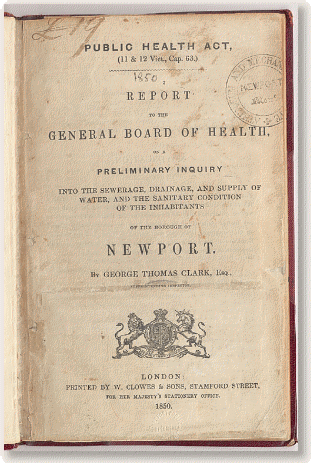
![]()
![]()
![]()
![]()
![]()
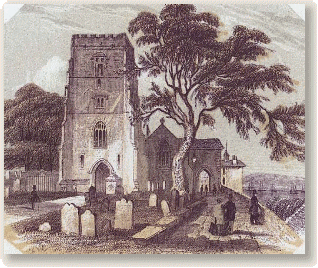
![]()
![]()
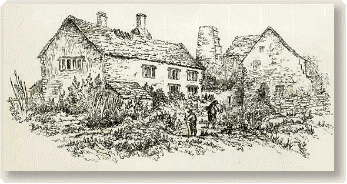
![]()
![]()
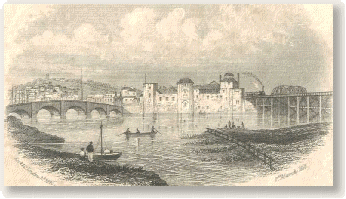
![]()
![]()
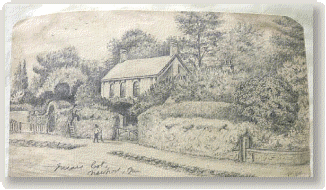
![]()
![]()
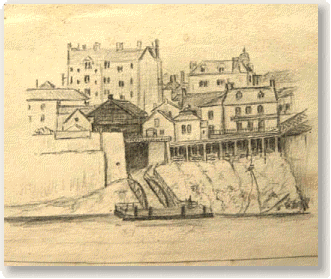
![]()
![]()
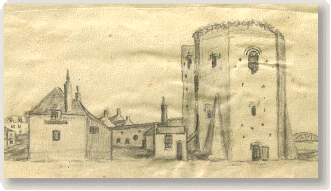
![]()
![]()
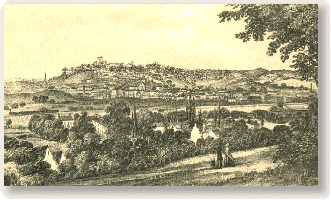
![]()
![]()

![]()
![]()
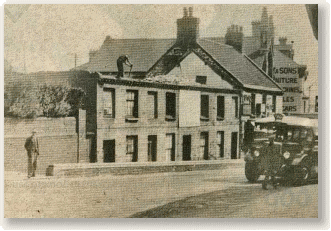
![]()
![]()
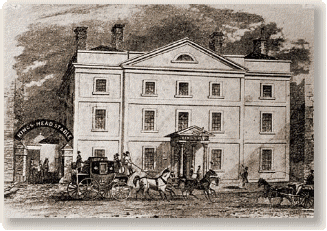
![]()
![]()
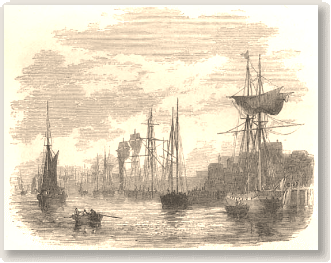
![]()
![]()
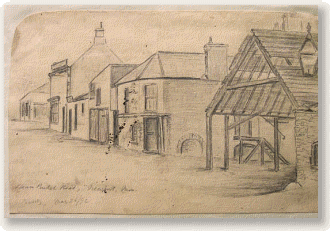
![]()
![]()
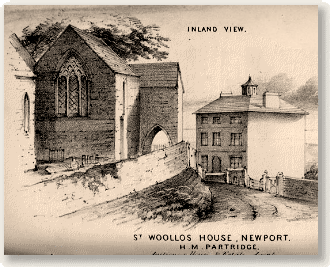
![]()
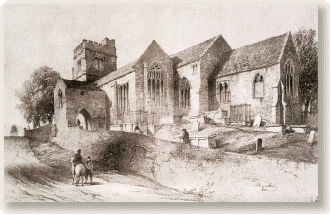
![]()
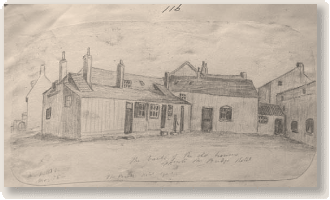
![]()
![]()
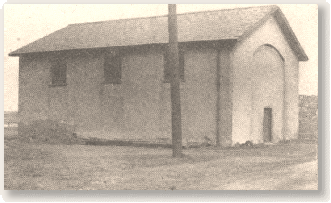
![]()
![]()
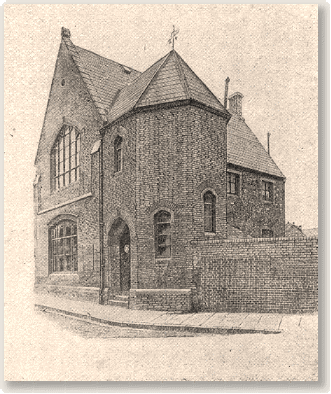
![]()
![]()
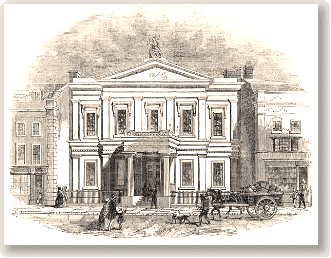
![]()
![]()
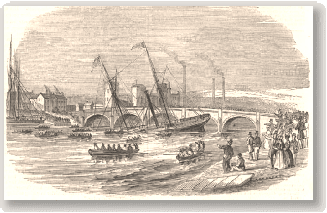
![]()
![]()

![]()
![]()
![]()
![]()
![]()
![]()
![]()
![]()
![]()
![]()
![]()

